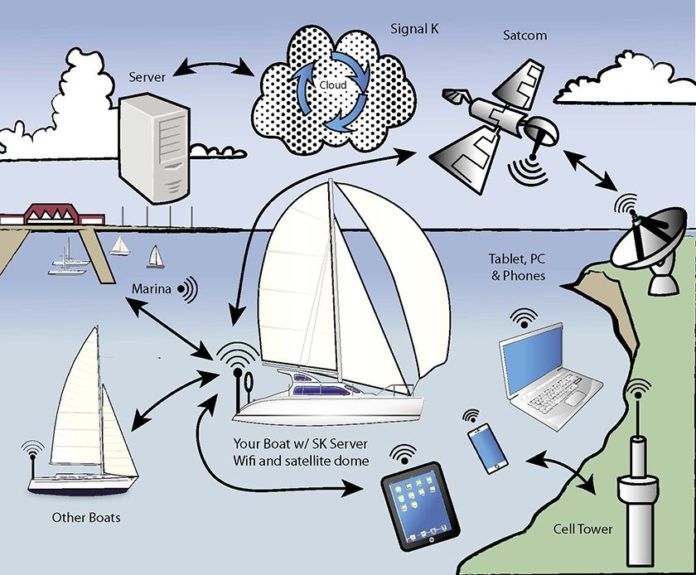Regina Gallant

How much data associated with your boating adventures are you willing to share with strangers? What are the costs and benefits of sharing this data?
In the upcoming December 2015 issue of Practical Sailor, contributor Bill Bishop describes the new open-source project known as Signal K that uses crowd-sourced data to make it easier for independent software developers to create marine-related apps. The assumption is that creative techies will use the freely available Signal K source code come up with helpful new apps that the big marine electronics companies are not willing to develop, or are slow to develop.
What makes a Signal K app different from an ordinary open-source software is that it would have the ability to integrate fairly seamlessly with our existing electronics. A new Signal K app would be able to draw from NMEA data (depth, boat speed, or wind speed, etc.), and use it for an app that would operate on a variety of handheld or fixed devices. (The Signal K software now works on a variety of inexpensive Linux-based processors such as the Raspberry Pi, and others.)
Not only will Signal K work with data acquired through NMEA devices, it can also use data acquired from other sensors used in other industries. For example, my interest in bottom paint led me to investigate how sensors that monitor fouling on dam turbines might be integrated into an app for sailors. (You know youre in deep when your idea of a perfect app is one that gleans slime growth data from sailboats around the world.) One highly-caffeinated (or otherwise impaired) reader suggested a coffee maker linked to the ships barometer-to automatically fortify the crew before a storm approaches. More practically, Bishop is satisfying his inner geek by building his own wind instruments that will work with Signal K. Other developers are working on everything from radar to autopilots.
Undoubtedly, Signal K is good news for the sailor who loves to tinker with computers. Hell be able to customize his electronics with apps that suit his own quirky needs. But even the non-techie can benefit. If Signal K really takes off, we can expect to see less expensive alternatives to big-ticket items such as chartplotters and instrument systems. Bishop predicts a bevy of affordable routing apps that are based on polar plots, the curved plots used by racers to predict their boats optimal velocity for a given wind angle and speed. Such polar-based tools and weather routing software are usually only available through relatively expensive racing software or proprietary systems. Based on the success of Digital Yacht’s Kickstarter campaign, which is offering its NMEA to Signal K gateway donors who give more than $229, there are plenty of people excited about this project.
The more controversial-in my mind-element of Signal K is how the data is used. Signal Ks success depends on the willingness of sailors to share data via the cloud. Were told, of course, that this is anonymous meta-data (the sort of non-identifying data with that the National Security Agency scrapes from phone records), and that the user can control which data he shares. Most of us are already sharing all kinds of information with various smart-phone apps, so this is nothing new.
Still, I worry.
The data sailors might share via such a cloud-based system is valuable and can be very personal. If given enough data, software developers can create programs to satisfy all sorts of creepy schemes. (Remember retail giant Targets use of an algorithm that analyzed spending data to determine which of its customers were pregnant?) I can imagine one purely hypothetical scenario (as far as I know) where in exchange for a free tide app a fisherman is unwittingly providing GPS co-ordinates for his favorite fishing holes. How happy would he be to learn these coordinates were later integrated into fishing charts sold nationwide? Bathymetric data from off-the-beaten path cruising sailors might be of interest to commercial fishing companies, undersea mining consortiums, or similar enterprises looking to tap the resources in remote areas that lack good charts.
Some privately collected data simply gets hoarded, so that sailors never see the benefit-or any benefit is years in coming. An example of this is the crowd-sourced community bottom depth data that commercial electronic chartmakers now collect from networked depth sounders on board commercial and recreational craft. Even though these chart companies rely heavily on the National Oceanic and Atmospheric Agencys taxpayer-funded charts to create the customized charts they sell to us, they refuse to share their community data with NOAA to improve its freely available government charts. This data is, the companies claim, proprietary data, and it is their right to use it as they see fit. (Others would certainly argue against giving crowd-sourced data-anonymous or not-to the government for any purpose.)
In theory, an open-source world would break down proprietary barriers to community data, but it is not necessarily the win-win scenario that proponents claim. Good data that we provide in good faith can help launch projects that some of us may have no interest in supporting. In my view, the benefits of open source software for sailors will far outweigh any cons, but we shouldnt just blithely accept data sharing as the next big thing. We need to be aware of the data we are sharing, whom we share it with, and how it is being used. Open source can work, so long as it is truly out in the open.

































